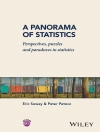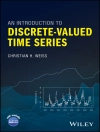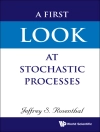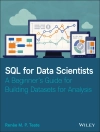Spatial epidemiology is the description and analysis of the
geographical distribution of disease. It is more important now than
ever, with modern threats such as bio-terrorism making such
analysis even more complex. This second edition of Statistical
Methods in Spatial Epidemiology is updated and expanded to
offer a complete coverage of the analysis and application of
spatial statistical methods. The book is divided into two main
sections: Part 1 introduces basic definitions and terminology,
along with map construction and some basic models. This is expanded
upon in Part II by applying this knowledge to the fundamental
problems within spatial epidemiology, such as disease
mapping, ecological analysis, disease clustering,
bio-terrorism, space-time analysis,
surveillance and infectious disease modelling.
* Provides a comprehensive overview of the main statistical
methods used in spatial epidemiology.
* Updated to include a new emphasis on bio-terrorism and disease
surveillance.
* Emphasizes the importance of space-time modelling and outlines
the practical application of the method.
* Discusses the wide range of software available for analyzing
spatial data, including Win BUGS, Sa TScan and R, and features an
accompanying website hosting related software.
* Contains numerous data sets, each representing a different
approach to the analysis, and provides an insight into various
modelling techniques.
This text is primarily aimed at medical statisticians,
researchers and practitioners from public health and epidemiology.
It is also suitable for postgraduate students of statistics and
epidemiology, as well professionals working in government
agencies.
สารบัญ
Preface and Acknowledgements to Second Edition.
Preface and Acknowledgements.
I: The Nature of Spatial Epidemiology.
1. Definitions, Terminolgy and Data Sets.
1.1 Map Hypotheses and Modelling Approaches.
1.2 Definitions and Data Examples.
1.3 Further definitions.
1.4 Some Data Examples.
2.Scales of Measurement and Data Availability.
2.1 Small Scale.
2.2 Large Scale.
2.3 Rate Dependence.
2.4 Data Quality and the Ecological Fallacy.
2.5 Edge E.ects.
3.Geographical Representation and Mapping.
3.1 Introduction and Definitions.
3.2 Maps and Mapping.
3.3 Statistical Accuracy.
3.4 Aggregation.
3.5 Mapping Issues related to Aggregated Data.
3.6 Conclusions.
4.Basic Models.
4.1 Sampling Considerations.
4.2 Likelihood-based and Bayesian Approaches.
4.3 Point Event Models.
4.4 Count Models.
5.Exploratory Approaches, Parametric Estimation and Inference.
5.1 Exploratory Methods.
5.2 Parameter Estimation.
5.3 Residual Diagnostics.
5.4 Hypothesis Testing.
5.5 Edge E.ects.
II:Important Problems in Spatial Epidemiology.
6.Small Scale: Disease Clustering.
6.1 Definition of Clusters and Clustering.
6.2 Modelling Issues.
6.3 Hypothesis Tests for Clustering.
6.4 Space-Time Clustering.
6.5 Clustering Examples.
6.6 Other Methods related to clustering.
7.Small Scale: Putative Sources of Hazard.
7.1 Introduction.
7.2 Study Design.
7.3 Problems of Inference.
7.4 Modelling the Hazard Exposure Risk.
7.5 Models for Case Event Data.
7.6 ACase Event Example.
7.7 Models for Count Data.
7.8 ACount Data Example.
7.9 Other Directions.
8. Large Scale: Disease Mapping.
8.1 Introduction.
8.2 Simple Statistical Representation.
8.3 Basic Models.
8.4 Advanced Methods.
8.5 Model Variants and Extensions.
8.6 Approximate Methods.
8.7 Multivariate Methods.
8.8 Evaluation of Model Performance.
8.9 Hypothesis Testing in Disease Mapping.
8.10 Space-Time Disease Mapping.
8.11 Spatial Survival and longitudinal data.
8.12 Disease Mapping: Case Studies.
9.Ecological Analysis and Scale Change.
9.1 Ecological Analysis: Introduction.
9.2 Small-Scale Modelling Issues.
9.3 Changes of Scale and MAUP.
9.4 A Simple Example: Sudden Infant Death in North Carolina.
9.5 ACase Study: Malaria and IDDM.
10.Infectious Disease Modelling.
10.1 Introduction.
10.2 General Model Development.
10.3 Spatial Model Development.
10.4 Modelling Special Cases for Individual Level Data.
10.5 Survival Analysis with spatial dependence.
10.6 Individual level data example.
10.7 Underascertainment and Censoring.
10.8 Conclusions.
11.Large Scale: Surveillance.
11.1 Process Control Methodology.
11.2 Spatio-Temporal Modelling.
11.3 Spatio-Temporal Monitoring.
11.4 Syndromic Surveillance.
11.5 Multivariate-Mulitfocus Surveillance.
11.6 Bayesian Approaches.
11.7 Computational Considerations.
11.8 Infectious Diseases.
11.9 Conclusions.
Appendix A:Monte Carlo Testing, Parametric Bootstrap and Simulation Envelopes.
Appendix B:Markov Chain Monte Carlo Methods.
Appendix C:Algorithms and Software.
Appendix D: Glossary of Estimators.
Appendix E:Software.
Bibliography.
Index.
เกี่ยวกับผู้แต่ง
Professor Andrew B. Lawson is a respected and well-known academic. He has published many papers in leading journals, and a number of books on spatial statistics, including five for Wiley.












